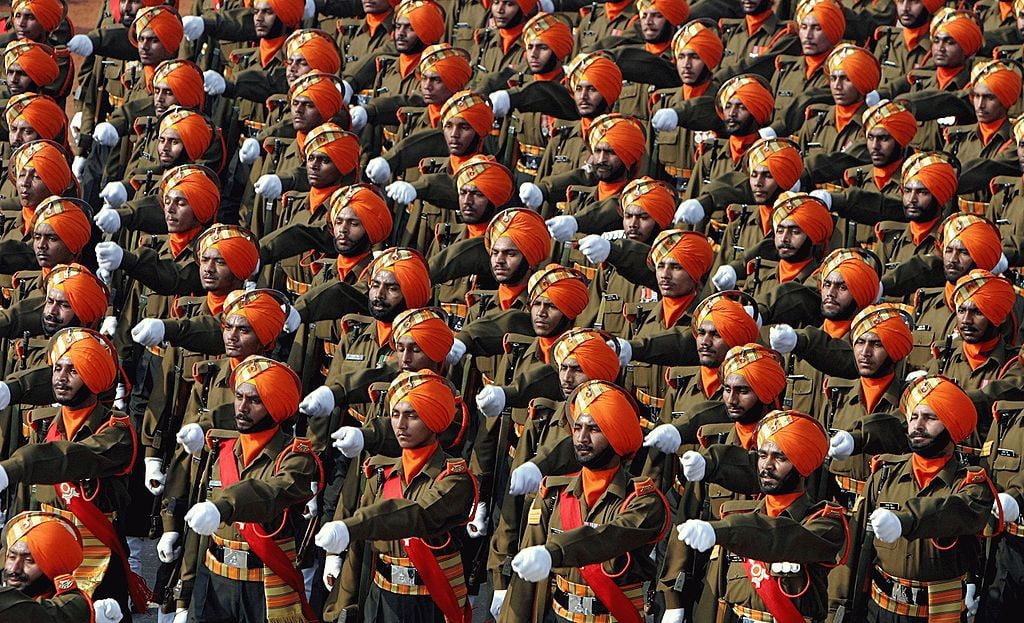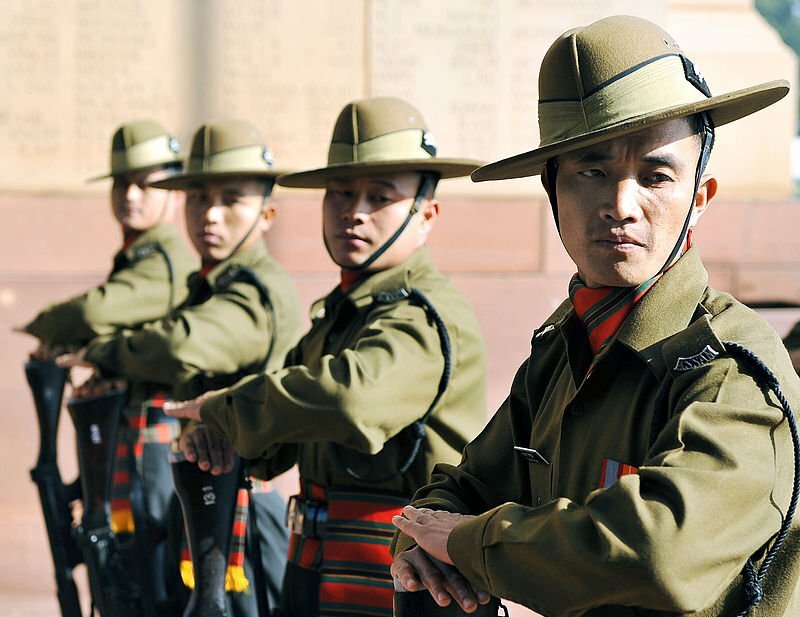
Indian Army has one of the finest soldiers in world in terms of training, motivation and morale. They are soldiers prepared to do and die – fight for a cause. But frankly they are not magicians who can produce pigeons or change the complexion of the battle and fight without a proper gun in their hands…
A soldier – at the very least needs a weapon. Would it be fair to expect the soldiers to fight a war without a weapon?
One of the primary reasons why India lost and suffered a humiliating defeat in the 1962 war was because the soldiers will ill-equipped, unacclamatized and totally unprepared to fight the war. The Indian Land forces fought the one month-long war at a height of 14,000 feet only at God’s mercy. The Indian side was over-confident that there would be no war. Nehru’s firmly believed that ‘not a blade of grass grows there’ and hence made no preparations. India had only two divisions of troops in the region of conflict.

As a result when the Chinese Army launched a twin attack in Ladakh and North East on October 20, 1962, the Indian jawans didn’t even have enough guns, ammunition or warm clothes to wear for fighting in extreme cold at such heights. The Indian political leadership ordered the Army to deploy jawans at every square kilometer of the border. The Army promptly responded to orders. The troops were ready to fight but there were no weapons, ammunition and maps for directions. The jawans had to physically pull the vehicles up to 14,000 feet. There were other basic military and logistics related problems.
On the other side almost three months before the war, the Chinese side had started augmenting its combat readiness and started stockpiling ammunition, weapons and gasoline.
The Chinese troops were acclimatized for high altitudes combat. They had proper clothing, shoes and weapons to fight in the mountains. The Chinese Army had occupied the highest ridges in the Rezang la (Chushul) in the western and Tawang in the eastern sector. China had constructed a road through Aksai Chin in 1956–57. This means that even six years before the war, the Chinese had visualized and built a road south of the Johnson Line connecting Xinjiang and Tibet. The result was that Aksai Chin was easily accessible to the Chinese, but Indian troops had to physically climb the Karakoram Mountains with great difficulty.
For instance an area called Barahoti was easily connected from the Chinese side. The Chinese used to come and occupy the area which was traditionally and Indian district headquarters and used to collect taxes from the traders there. That was so when Narender Kumar nicknamed “Bull” was tasked to lead Indian Army troops to occupy Barahoti for the first time. For this then just a young Capt he was awarded Ati Vishist Seva Medal (AVSM) normally given to generals. The citation read, “In April 1961, he (Capt Kumar) was ordered to establish an outpost near U.P- Tibet border. He displayed great determination and organizing ability in leading his party over mountain about 18000 ft high against very heavy odds and fulfilling the task. On another occasion he displayed remarkable courage in locating an aircraft which had crashed in mountain terrain.” This shows the dedication of Indian soldiers.
Even many Chinese troops were killed in the freezing cold in 1962. This was nothing new, even during the Italian Campaign of World War I more casualties were caused by the harsh weather than the enemy action. The 1962 Indo-China War was no different.
After the war, bodies of many Indians soldiers were recovered buried in the ice, frozen — but with weapons in their hand. Even the Chinese acknowledge the fact that the Indian troops wanted to fight –last man last round — till the bitter end.

The Sino-Indian War teaches us a lesson how not to go to war – unprepared, inadequately armed and clothed in extremely inhospitable and harsh mountain conditions at altitudes over 4,000 metres (14,000 feet) where most of the fighting took place. The 1962 War was an intelligence failure. But above all, the biggest blunder in the 1962 war was that while the Army was taking the bashing, the Indian Air Force and Indian Navy were not even deployed. They kept watching the ‘game’ from the pavilion.
As a result when the war ended when the Chinese declared ceasefire on 20 November 1962, and simultaneously announced its withdrawal from the disputed area — India had suffered the heavy casualties –4,885 soldiers killed, 3,968 taken prisoners of war and 1,697 wounded. On the other China only had 722 soldiers killed and 1,696 wounded.
“It was a Himalayan blunder. We went to war a bit too early, our army was not prepared. It was also because people like Gen Kaul who was from ASC were made Chief of Staff. He misguided Pt Nehru”, says Col Narendra Kumar a living legend in the field of mountaineering and High Altitude warfare in India. A key forward logistics post at the base of Siachin Glacier -the highest battlefield in the world at a height of 4,880 m named — “Kumar Base”, after him.
As Napoleon said, “God is on the side of the battalions with the bigger cannon.” Two of the greatest lessons to be learnt from this war were – never go to war without doing your homework. Two never underestimate your enemy and always have a gun in hand and adequate ammunition in your pocket.
Another aspect of the 1962 of the war was that while the Chinese People’s Liberation Army, was armed with advanced semi-automatic and automatic rifles the Indian Army was strutting around with British army discards.
The Babu’s in the defense ministry could not visualize the fact that Wars are fought with weapons and equipment not statistics of money saved buy not spending where it is needed. The Indian Army was living in a make believe fancy dress parade, playing soldier-soldier with the obsolete, world war vintage Lee-Enfield rifle and Webley Mk IV revolvers.
The bolt action rifles had been the standard arm since World War I and World War II. The bolt-action rifle fired a single shot with each pull of the trigger. The shooter then had to reload manually, by withdrawing the bolt and then returning it to its place, which made a fresh cartridge slide into the chamber from the magazine below the rifle’s belly. The bolt-action Lee-Enfield .303 SMLE with a 10-round magazine – had been one of the fastest military bolt-action rifle of its times.
It was a good, accurate and reliable rifle capable of firing 30 aimed shots per minute, quite a bit for any non-automatic rifle. But at a time when the British was discarding the bolt action guns in favor of semi automatic weapons after the World wars, the Indian Ministry of Defense like a typical scrap dealer, decided to make it standard issue weapon for the Indian Army.
80s Militancy in Punjab & Counter Insurgency
The last 70s and early 80s added a new dimension in warfare. The army now had to face – the terrorists. From the militants in Punjab and Kashmir to LTTE in Sri Lanka the adversaries were using the AK-47.The army now wanted a rifle with a longer barrel — that would give the bullet higher speed and greater power of impact. No such product was given to them.
Necessity they say is the mother of invention, as a stop gap solution the Indian Armed forces and police forces started equipping themselves with the over 20,000 AK-47s captured from insurgents. In Punjab some resourceful police officers used their own resources to develop a bullet-proof tractor which could offer armor protection and mobility in rugged terrain.
A Punjab police officer interrogating a terrorist was in for a rude shock when a terrorist asked him to treat him properly. “Why,” asked the officer. “Well all your new weapons, equipment and wireless sets are because of us. Had it not been for us you would have still been moving around in old British discard jeeps and bolt action guns,” he said.
Kargil 1999: Another war -a bigger jolt
Many years later the Indian defense ministry received a big jolt when mujahedeen fighters backed by regular Pakistani Army silently intruded into Indian territory in the kargil-Batalik sector. The Indian troops who went to fight the high-attitude war in Kargil -Dras sector were issued INSAS rifles for the first time. The INSAS repeatedly got jammed while its magazine and metal parts cracked due to the extreme cold. The rifle went into automatic firing mode when it was set for three-round burst. Apart from this oil sprayed by the rifled caused many eye injuries to the troops.
That was till some Indian troops including some Gurkhas picked up the Kalashnikovs of the fallen Pakistanis because they were better and more accurate than their own guns.
Is this a way to fight a war? How do you expect the soldier to fight- with his bare hands?

